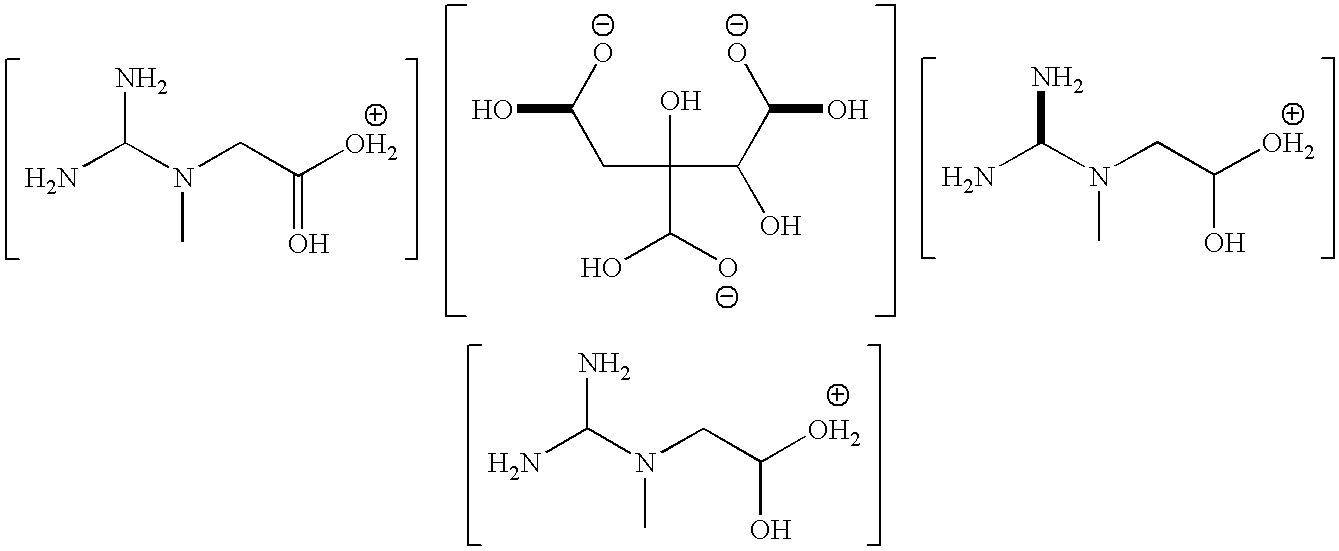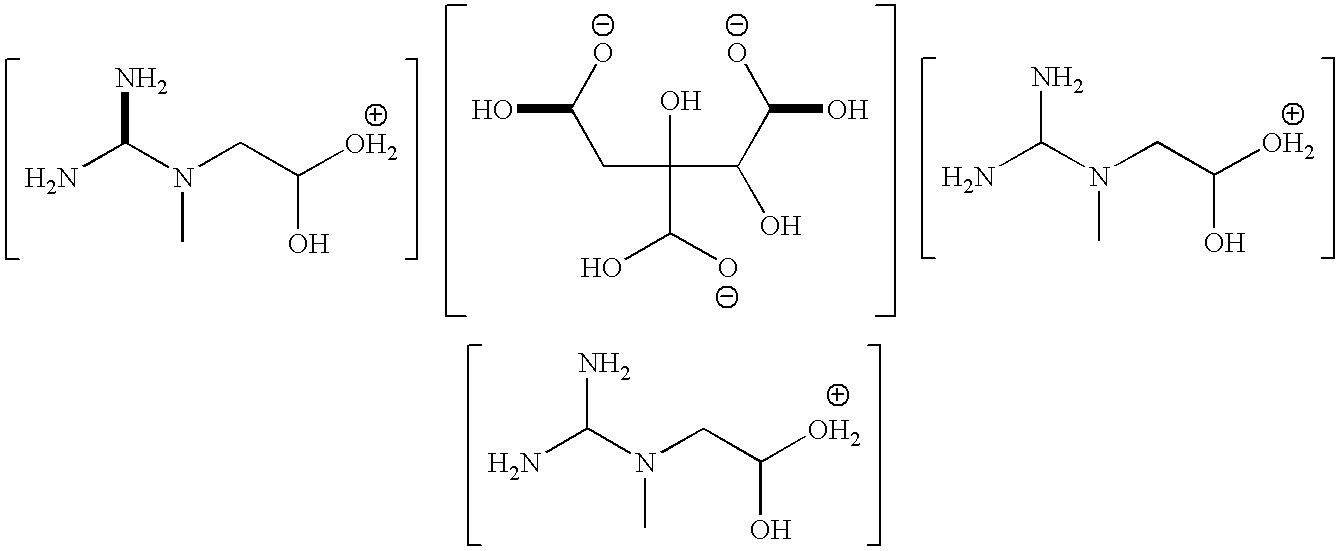Creatine hydroxycitric acids salts and methods for their production and use in individuals
- Summary
- Abstract
- Description
- Claims
- Application Information
AI Technical Summary
Benefits of technology
Problems solved by technology
Method used
Image
Examples
example 1
Creatine Dipotassium Hydroxycitrate Monohydrate, Dicreatine Monopotassium Hydroxycitrate Monohydrate, and Tricreatine Hydroxycitrate Monohydrate
[0038] The fruits rinds of G. cambogia and G. indica may contain 20-30% (−)-HCA (Reference: Lewis, Y. S., and Neelakantan S. (−)-Hydroxycitric acids. The principle acid in the fruit is Garcinia cambogia. Pytochemistry 4:619-625, 1965). To provide reaction yields of not less than 50% (−)-HCA on anhydrous basis acid content, the fruit rinds of G. cambogia and G. indica may preferably contain a minimum of about 15% (−)-HCA.
[0039] Accordingly, it is estimated that 208.13g of (−)-HCA can be extracted from a starting amount of 1.3875 kg of Garcinia fruit rind. The extraction process may be similar to the process described by e.g. Majeed, M., et al. in U.S. Pat. No. 5,783,603, in which hydrosoluble (tri)potassium hydroxycitrate salts are described. That process involves the extraction of (−)-HCA from Garcinia fruit using an alkyl alcohol.
[0040] ...
example 2
Tricreatine Hydroxycitrate
[0053] Free (−)-HCA can easily be generated from calcium, sodium and potassium hydroxycitrate salts, by passing an aqueous solution of said salt through a cation exchange resin, e.g., Zeocarb® 225. (Reference: Singh, R. P., et al., (−)-Hydroxycitric acid from Garcinia cambogia. Biological Memoirs 21(1):27-33, 1995).
[0054] Hydroxycitric acid has a molecular weight of 208.13. Creatine monohydrate has a molecular weight of 149.13. Tricreatine hydroxycitrate may be manufactured as follows:
[0055] Step 1) Start with 10.84 l of anhydrous methyl alcohol;
[0056] Step 2) With stirring, an aqueous solution containing 1,084 g of hydroxycitric acid (5.2 moles), obtained after passing the (−)-HCA salt through a cation exchange resin, are added to the anhydrous methyl alcohol. The resulting mixture is stirred for approximately 45 minutes;
[0057] Step 3) 2,362 g (15.6 moles) or creatine monohydrate are added to the hydroxycitric acid / methyl alcohol mixture. This mixtur...
example 3
Preparation of Tricreatine Hydroxycitrate from Creatine Hydrochloride and (Tri)-Potassium Hydroxycitrate Monohydrate
[0064] Tripotassium hydroxycitrate monohydrate has a molecular weight of 340.41 g per mole. Creatine hydrochloride has a theoretical molecular weight of 167.57 g per mole.
[0065] The procedure is a follows:
[0066] Step 1) 3.5 g of tripotassium hydroxycitrate monohydrate (0.01 mol) is mixed in sufficient deionized water to a final volume of 300 ml;
[0067] Step 2) To the solution described above, creatine hydrochloride is added in an amount of 5.03 g (0.03 mol) and solution is stirred for 45 minutes;
[0068] Step 3) The resulting product is tricreatine hydroxycitrate (5.8-6%), having three creatine cations per hydroxycitrate (tri)-anion.
[0069] Step 4) Potassium chloride, also obtains via this reaction, can be precipitated with the addition of alcohol (ethanol, methanol) and removed by filtration.
[0070] Given that the described reaction mixture includes 0.01 moles of tr...
PUM
| Property | Measurement | Unit |
|---|---|---|
| Melting point | aaaaa | aaaaa |
| Molecular weight | aaaaa | aaaaa |
| Weight loss | aaaaa | aaaaa |
Abstract
Description
Claims
Application Information
 Login to View More
Login to View More - R&D
- Intellectual Property
- Life Sciences
- Materials
- Tech Scout
- Unparalleled Data Quality
- Higher Quality Content
- 60% Fewer Hallucinations
Browse by: Latest US Patents, China's latest patents, Technical Efficacy Thesaurus, Application Domain, Technology Topic, Popular Technical Reports.
© 2025 PatSnap. All rights reserved.Legal|Privacy policy|Modern Slavery Act Transparency Statement|Sitemap|About US| Contact US: help@patsnap.com


